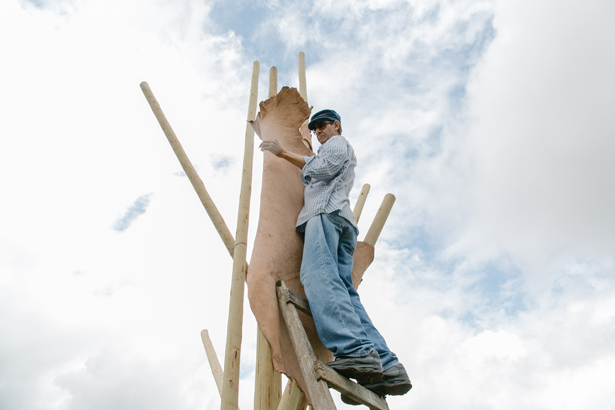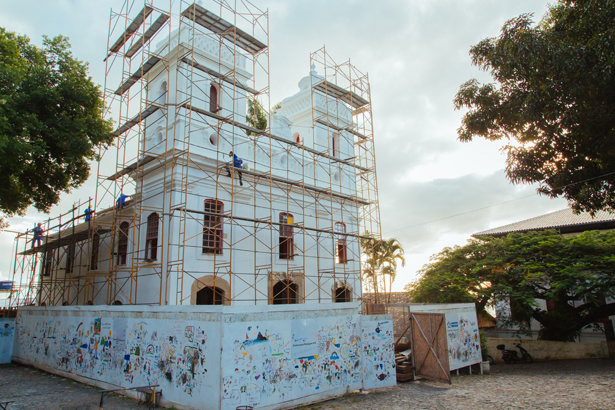May 29–September 7, 2014
Museu de Arte Moderna da Bahia (MAM-BA)
Av. Contorno s/n – Solar do Unhão
40060-060 Salvador (BA)
Brazil
Actions and exhibitions are scattered between Bahia’s Museum of Modern Art (main) and 30 locations in Salvador and other ten cities in the State of Bahia, Brazil.
The 3rd Bahia Biennale (Bienal da Bahia) enters its final phase with all of the 30-plus exhibitions, film cycles and actions spread all over Salvador and the state of Bahia along with several artistic occupations of public and private spaces. Artists in residence unveil their final works, developed since the start of the year, while the ongoing debates about the possibilities of a Biennial model outside of the established system and its markets extend to actual instances of living art.
Camila Sposati digs her Earth Anatomic Theatre in Itaparica Island, where it will stay long after the Biennale is finished, while Nuno Ramos’s Iluminai od Terreiros (Set the Terraces Alight) project explores inaccessible sites of Salvador in one-off interventions offering a unique experience of estrangement and illumination. Teatro Castro Alves’s modernist design, in downtown Salvador, is the locus of an architectural intervention by Luís Berríos-Negrón, and Salvador’s Central Library (Barris) awakens its ghosts with Omar Salomão’s sound installation.
The Archive and Fiction Working Group, curated by Ana Pato, deepens its original proposal to exchange experiences, research and content production about artistic practices and archival procedures. Throughout its workshops, lost archives and collections are being identified and mapped, offering a broad range of materials for commissioned artists (Eustáquio Neves, Gaio Matos, Rodrigo Matheus, Paulo Nazareth, Ícaro Lira, Gisele Beiguelman) to carry out artworks specially designed for the 3rd Biennale. The State Archives, located in a 16th-century building, displays the results of these works together with an exhibition of articles unearthed from the police archives—including Candomblé items confiscated throughout decades of repression of the Afro-Brazilian religion as well as mortuary masks and mummified corpses of cangaceiros (country bandits of the 1920s and 1930s).
The Imaginary Museum of the Northeast spreads its occupation of public spaces with exhibition sets designed to offer a critical alternative to the very concept of the museum: as a privileged space to reinvent and reorganize the past in order to tune it to the public. According to chief curator Marcelo Rezende, “we see the Northeast, the cradle of the ‘Brazilian civilization,’ as a place where actions, ideas and objects from all over the world have set foot, and now we collect the pieces of all this history in different spaces, each dedicated to a particular subject.” The I.M.N. brings together artists from different nationalities, such as Charbel-joseph Boutros (Lebanon), the works of Yves Klein or the German writer Arno Schmidt, interacting with the local production and the cultural heritage of Salvador. As a conceptual centrepiece of the Bienal, the Naturalisme Integral of Pierre Restany, Frans Krajcberg and Sepp Baendereck is regaled with a special exhibition dedicated to the pioneers and followers of environmental art.
The extensive research on a whole generation of Bahia artists working since the 1960s and 1970s brings comprehensive exhibitions of Bahian masters left in the fringes of the art circuit until now: Rogério Duarte, visual guru of Tropicalism; Juarez Paraíso and his cosmic-fiction universe on canvas and other dimensions; the environmental art of pioneer Juraci Dórea; and the psychedelic creations of Dicinho and Edinízio Primo. Borne out of an original research by chief curator Ayrson Heráclito, rare works, previously regarded as long lost, of the PEBA movement, from which some of the most important names of the Brazilian art scene of the last 40 years emerged (e.g Caetano Veloso and Gilberto Gil), have their first significant exposure since the heyday of the late 1960s/early 1970s.
Since May 29, the 3rd Bahia Biennial has offered a privileged ground for artists and creators from 22 countries and several states of Brazil to develop independent works and research, while also spreading contemporary issues and artistic experiences to communities dwelling in the margins of the art circuit. This is not a one-way movement as the actions have furthered the exchange of practices, issues and ideas from different, and sometimes opposite social spheres.
Churches, universities, cultural centres, libraries, Candomblé temples, schools and ateliers host exhibitions, workshops and artistic occupations, offering not only a broad range of visiting circuits but also an active dialogue about spaces and the artistic endeavours interacting within them. It is the process that matters, material or immaterial: Bahia closes a gap of 46 years since its last Biennale was closed by the military regime (1968), and the third edition is proud to bring back to life the spirit of an artistic élan long repressed.
The 3rd Bahia Biennale reaffirms the intentions of the original project: to establish a counter-discourse that is suitable for creating, promoting and establishing alternative routes in the art field, without the need to depend on legitimation from other national and international centres. The Biennale also updates the original project to the current Brazilian and international contexts, where the concepts of center and periphery are being redefined.
The 3rd Bahia Biennale is a project of Secretaria de Cultura do Estado da Bahia (State of Bahia’s Culture Department), organised by Bahia’s Museum of Modern Art (MAM-BA) through a joint venture between Hansen Bahia Foundation and Instituto do Patrimônio Artístico e Cultural (IPAC – Institute for the Cultural and Artistic Heritage). The Biennale curatorship is led by MAM-BA director Marcelo Rezende, assisted by Ana Pato and Ayrson Heráclito (chief curators), Fernando Oliva and Alejandra Muñoz (co-curators).
All events and schedule subject to change. For updates and further events, check www.bienaldabahia.com.
For more information
Eduardo Simantob: eduardo@bienaldabahia.com / T +55 71 9114 8044
All exhibitions, performances and public actions are free.


